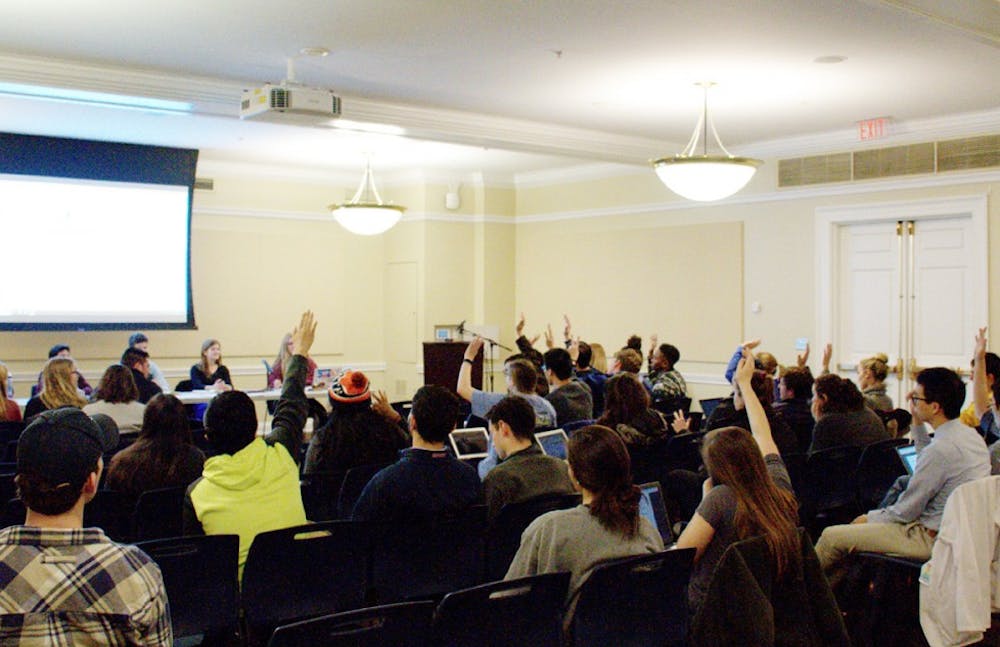The University Board of Elections announced New Student Election results Thursday evening. In the first-year elections, approximately 35 percent of students voted for First-Year Council president, 33 percent for First-Year Council vice president and 31 percent for First-Year Student Council representatives. Out of 655 eligible transfer students, 57 students — or 8.7 percent — voted in the election for the transfer representative.
First-years elected College students Jared Rooker and Anisa Mohamed as First-Year Council president and vice president, respectively, and Engineering student Cutter Huston, College student Neha Rana and College student Cooper Scher as Student Council representatives.
In an interview with The Cavalier Daily, Rooker and Mohamed said they are looking forward to unifying their class. Rooker — who, as president, is also an appointed member of Student Council — said he hopes to provide a platform to represent his classmates’ views.
“I feel kind of like a tool for them — the class as a whole — to just funnel all their wants and beliefs into us,” Rooker said. “And then we're supposed to make that happen.”
In addition, transfer students elected second-year College student Raheel Tauyyab to the Student Council transfer representative position. Tauyyab said he hopes to bring the University’s attention to challenges that are specific to transfer students, such as adjusting to academic challenges and community-building.
“It's really difficult coming from university, whereas you think you know what you're doing, but it's a completely different environment,” Tauyyab said. “And when you come to it, you might feel a little stressed about that…And then just building a community where a lot of times transfers just feel like they're left out.”
Turnout for First-Year Council elections improved compared to last year’s lows, when only 30 percent of students voted for president, 28 percent for vice president and 24 percent for representatives.
Compared to last year, transfer student turnout dropped slightly. Transfer student turnout has been consistently low in the past — within the past five years, the highest rate of transfer voters in this particular election was just over 15 percent in 2016.
Tauyyab noted that the particularly low voter turnout among transfer students is related to a lack of information and involvement, as well as an overarching sense of apathy among the population. Tauyyab said he aims to promote participation in student self-governance among his peers through his position.
“In a larger part it is getting people to feel like they're actually a part of something, and not just the fact that you're doing something because you need to or that it's even that it's your responsibility, but the fact that you have the power to change something,” Tauyyab said. “That's something that I really want to hammer down throughout this term.”
Mason Fuller, a fourth-year College student and chair of UBE, said in an email statement to The Cavalier Daily that this year’s first-year voter turnout was significant compared to last year’s New Student Election, as well as turnout for last semester’s University-wide election for Student Council, Honor Committee and University Judiciary Committee elected positions and referenda.
At the beginning of this semester, the Honor Committee repealed an impeachment amendment that passed last spring because out of the 10.51 percent of the student body who voted on the amendment, 89.41 percent of students who voted were in favor. According to Honor’s Constitution, at least 10 percent of the student body must vote in favor of an amendment for it to pass, and the portion of the total student body in favor of the amendment was 9.39 percent.
Fuller noted that last semester 12 percent of the student body voted in the general election. Fuller said that, while there may be a variety of reasons for the disparity between voter turnout in New Student Elections versus the University-wide election, one major factor for such high participation among first-years may be that they live in a concentrated area and can therefore campaign more effectively.
“The increase in participation is no small feat and is something that they can all collectively take pride in,” Fuller said. “The elections process is such an important one at the University, and I encourage all of them to stay involved with it throughout their time here.”







